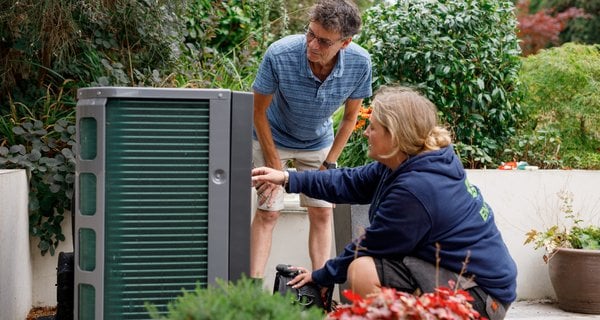The pilot demonstrated the potential of intelligent infrared heating systems to provide reliable heating throughout the winter months, but also highlighted potential challenges social housing providers might face when delivering similar work.
This project also highlighted the value of piloting these approaches with a small number of properties before considering wider roll-out. Reflections from this pilot can inform the decision-making process for potential wider roll-out by other local authorities or social housing providers. Below, we list our key recommendations for social housing providers looking to pilot or roll out intelligent infrared heating systems.
1. Provide clear and accessible information and support to tenants
Tenants appreciated the convenience and innovative features, but faced challenges in adapting to the new technology. Social housing providers should provide clear and accessible support and information for tenants. It is important to provide a comprehensive induction to new tenants that includes a demonstration of how the system works, and clear written instructions.
This should be followed up with regular check-ins and support (both over the phone and in person) to address any lingering concerns and questions. The housing providers should also provide support to tenants who are not comfortable using smartphones, such as printed instructions or training sessions.
Moreover, the tenants mentioned not being able to ask the Council for assistance related to the use of the system. While it is not the social housing providers' role to provide complex technical support on the technology itself, feedback from tenants underscores the importance of good collaboration and knowledge sharing between the social housing and the heating technology providers.
2. Adapt the process to be responsive to tenants’ needs and capacity to engage with the process
One of the tenants found it particularly difficult to engage with the onboarding process, which negatively impacted their ability to use the system effectively. Tenants’ capacity to engage and, by extension, their experience of using the system is impacted by a variety of factors that should be taken into account such as feeling overwhelmed about moving into a new property, being at risk of fuel poverty, having small children or having limited experience of managing household bills.
Offering additional, tailored support to these tenants, especially those who are vulnerable, is crucial, particularly early on in the process. For example, this could be done by prioritising key information (such as setting up the heating schedule and basic functionalities) during the onboarding process. Additional information could be provided gradually over time or made available through easily accessible resources.
Moreover, housing providers should consider whether some tenants might be more comfortable with more traditional user interfaces that don’t require as much tweaking or that have simplified controls designed specifically for social housing.
3. Ensure tenants are on a monthly billing plan and the right tariff prior to or within the first weeks of moving in
Being on a monthly payment plan and the right electricity tariff is key to ensuring that the potential energy savings are realised. Social housing providers should collaborate closely with utility providers to ensure tenants have access to appropriate tariffs and billing plans that maximise the benefits of solar generation and battery storage. Ideally, an appropriate tariff should be set up before the tenant moves in, rather than relying on the tenant to switch to an appropriate tariff themselves.
4. Provide clear information about energy consumption through In Home Displays and monthly billing
Both tenants had above average energy consumption throughout winter, which could, in part, be explained by the tenants increasing their energy use because the ‘clean’ or ‘green’ heat was perceived as being cheaper than gas heating. To mitigate against this, tenants need to understand how much energy they are using and how much it is costing them. The tenants should be provided with clear information about energy consumption and costs, including regular updates on usage and bills. This information should be displayed in different formats to aid accessibility. In Home Displays (displaying information from a smart meter) should be provided to help tenants to monitor their daily energy spend. Recent evidence suggests In Home Displays (displaying information from a smart meter) could help householders to make informed decisions about their energy use and can help them to budget effectively.
5. Plan for what will happen if expected energy savings are not realised
Low-carbon heating technologies have the potential to save tenants money on their heating bills. However, the expected savings are not always realised due to issues with installation, tenants being unable to access the best tariffs or to use the system as it was designed. While social housing tenants are generally responsible for paying for their own energy bills, social housing providers piloting new technologies should plan for what will happen if the expected energy savings do not materialise.
This could include, for example:
- reimbursing participants for part of their energy costs incurred during the pilot
- at the end of the pilot, offering the option to have their system altered to better meet their needs, or offering the option to move to a different property.



